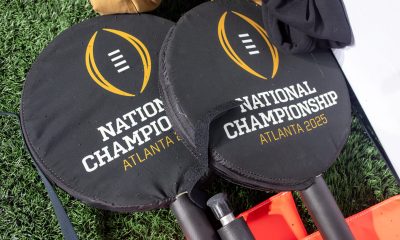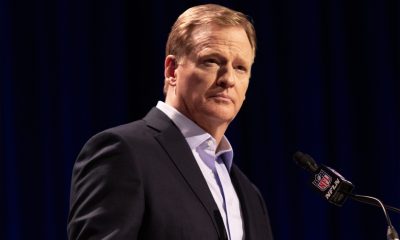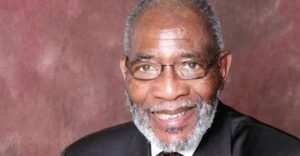Black History
Three Minneapolis women who broke cheerleading color barriers
MINNESOTA SPOKESMAN-RECORDER — Prior to 1923, cheerleading had been an exclusively White male activity. That year, the University of Minnesota (U of M) became the first school in America to allow female cheerleaders. It remained an all-White activity there, however, until Dana Purdue Williams became the first African American cheerleader at the U of M in 1975.
By Ken Foxworth
Two trailblazing cheerleaders were recognized at St. Peter’s Church in Minneapolis: (l-r) Harriet Bowman Solomon, Gwendolyn Morrow Fraction; Rev. Carla Mitchell, pastor of St. Peter’s; and former Minneapolis Public Schools.superintendent Dr. Carolyn Johnson.
Few people realize that not only did women athletes cheerleading at sporting events originate right here in Minnesota, but also several strong African American women made Black history here by breaking the cheerleading color barrier.
Prior to 1923, cheerleading had been an exclusively White male activity. That year, the University of Minnesota (U of M) became the first school in America to allow female cheerleaders. It remained an all-White activity there, however, until Dana Purdue Williams became the first African American cheerleader at the U of M in 1975.
Below are Williams’ story and two other earlier cheerleading firsts that inspired her to pursue her own dream.
Gwendolyn Morrow Fraction
A 1950 Minneapolis North High School graduate, Fraction became in 1949 the first African American cheerleader in the state of Minnesota. Upon graduation, she worked for Northwestern Bell and in banking, insurance, and accounting. At age 85, Fraction still volunteers in the community and is known for her beautiful voice.
Following in her mother’s footsteps, Fraction’s daughter Cindy became a cheerleader for Washburn High School, graduated in 1983, and is now program director of research at the University of St. Thomas.
Harriet Bowman Solomon
A 1951 Central High School graduate, Solomon watched her brothers play football and other extracurricular activities. Her brother Earl Wesley Bowman attended college on a football scholarship, played baseball at a major university, played semi-pro football, and became the first African American president of Minneapolis Community College. Her other brother, Henry Bowman, was a member of the Tuskegee Airmen as well as a Big 10 regional player.
Harriet wanted to establish her own legacy and accomplished this through cheerleading. She was the first African American cheerleader at Minneapolis Central High in 1950 and later worked for Northwestern Bell. After retirement in 1995, she volunteered at McRae Park.
Edward C. Soloman Park near Lake Nokomis in Minneapolis was named after Harriet’s husband for his outstanding contribution to the Minneapolis park system as a board member and a volunteer at McRae Park
Dana Purdue Williams
This 1975 Washburn High School graduate who went on to become the U of M’s first Black cheerleader says that at an early age she watched her mother, Harriet Bowman Solomon, cheerleading in the kitchen, living room, or anywhere else where she had space and a chance. She also watched her best friend Gwendolyn Morrow Fraction doing the same, all while having fun.

MSR News Online/MSR News Online Dana Purdue Williams as a U of M cheerleader in 1975
Williams recalls her mother enrolling her in ballet classes at the tender age of six. At age 10 she attended the Minnesota Dance Theater children’s workshop, where she became an apprentice and mastered the program by age 15.
She thought all of that experience and her mom’s example put her in position to make Minnesota Gopher history. “When I saw the 1975 tryout poster for the University of Minnesota cheerleading squad,” Williams says, “I truly knew that I was ready to go complete. I saw myself being a Gopher cheerleader at the age of seven. I planned this all my life, and no one was going to stop me from pursuing my dream!”
As Williams took her inspiration from predecessors Fraction and Solomon, so did she take their career advice, becoming a flight attendant for 40 years at Delta/Northwest Orient Airlines. She now works as an ambassador for Delta Airlines, visiting their headquarters in Atlanta, GA to inspire and motivate future flight attendants to be all that they can be for the customers and the company.
Williams has also has been giving back to her community through the years by helping young inner-city girls and working with football camps at McRae Park in South Minneapolis.
Cheerleading history’s importance
The most important thing in sports is not just the games and their players — it’s the fans and their enthusiasm that makes the games so wonderful. And who is it that gets the fans yelling themselves raw cheering on their teams to victory? That’s what the cheerleaders do, though rarely do they get credited for their athletic contributions to the sports world.
Not so long ago, cheerleading was the only opportunity for girls to be seen and heard as athletes at their schools, colleges and universities. Before the Title IX federal civil rights law came into effect in 1973, girls did not have the same opportunities as boys to develop their skills in sports. The only thing they could do was to go out on that field and cheer on their team.
Fraction, Solomon and Williams all made important strides for Black women athletes between 1949 and 1975. Thanks to them and many others like them, girls around the Twin Cities can now aspire not only to become cheerleaders in high school and their respective universities and colleges. Now they can aspire to compete as athletes in any sport that captures their dreams.
This article originally appeared in the Minnesota Spokesman-Recorder.
Activism
Oakland Post: Week of November 26 – December 2, 2025
The printed Weekly Edition of the Oakland Post: Week of November 26 – December 2, 2025
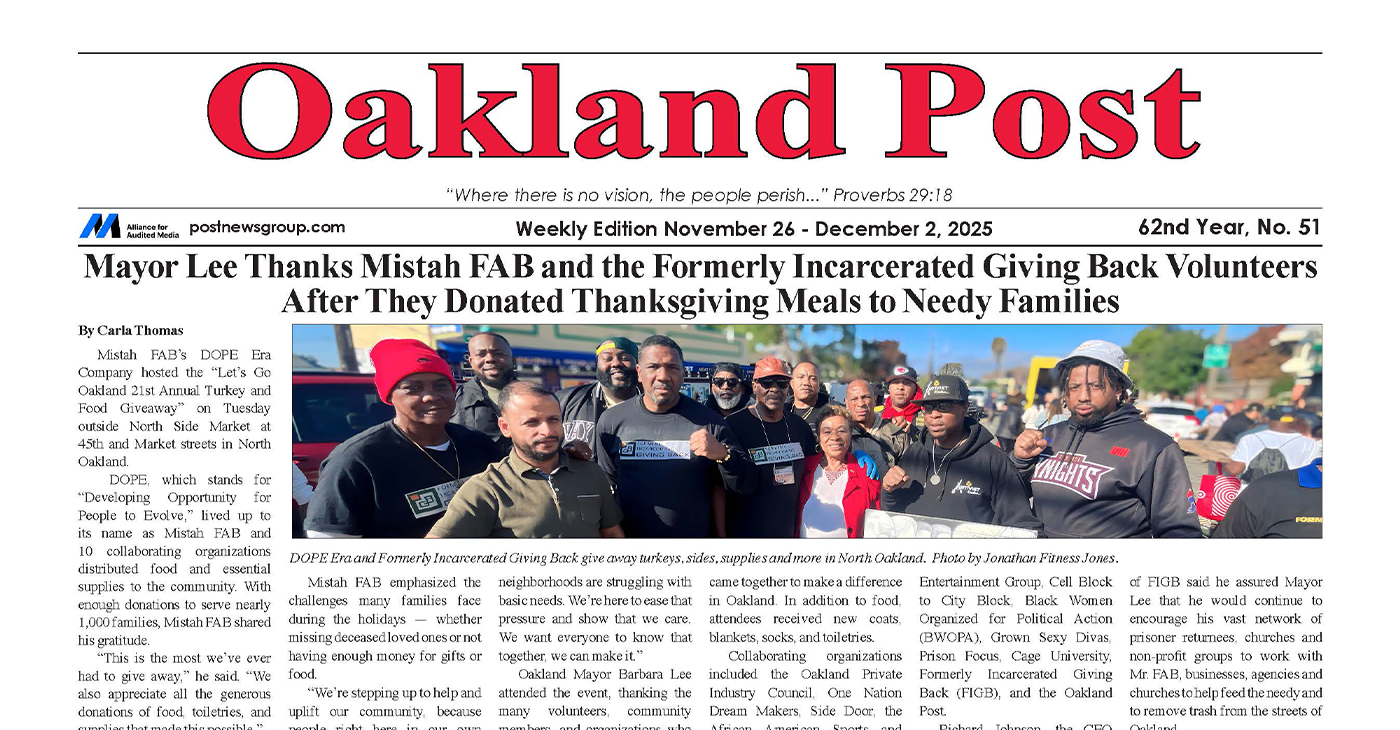
To enlarge your view of this issue, use the slider, magnifying glass icon or full page icon in the lower right corner of the browser window.
Activism
Oakland Post: Week of November 19 – 25, 2025
The printed Weekly Edition of the Oakland Post: Week of November 19 – 25, 2025
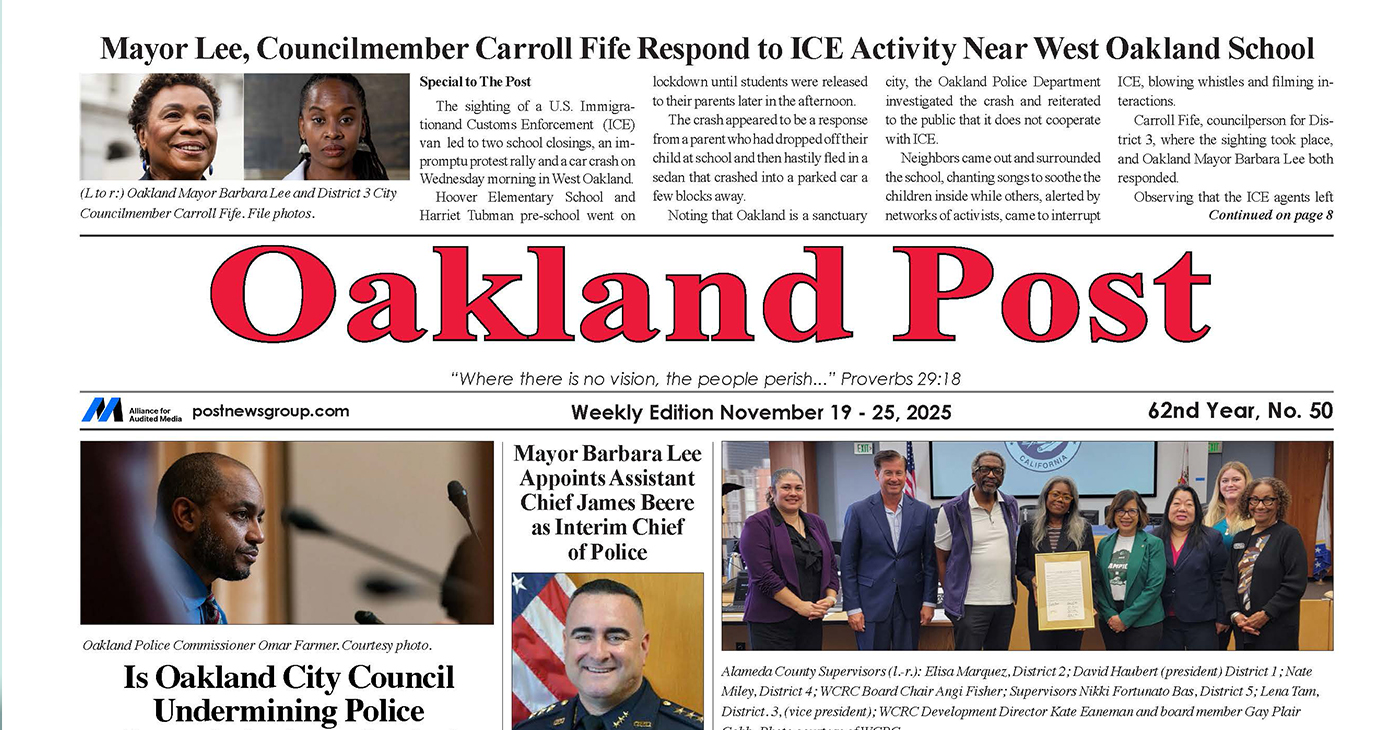
To enlarge your view of this issue, use the slider, magnifying glass icon or full page icon in the lower right corner of the browser window.
Activism
IN MEMORIAM: William ‘Bill’ Patterson, 94
Bill devoted his life to public service and education. In 1971, he became the founding director for the Peralta Community College Foundation, he also became an administrator for Oakland Parks and Recreation overseeing 23 recreation centers, the Oakland Zoo, Children’s Fairyland, Lake Merritt, and the Henry J. Kaiser Convention Center.
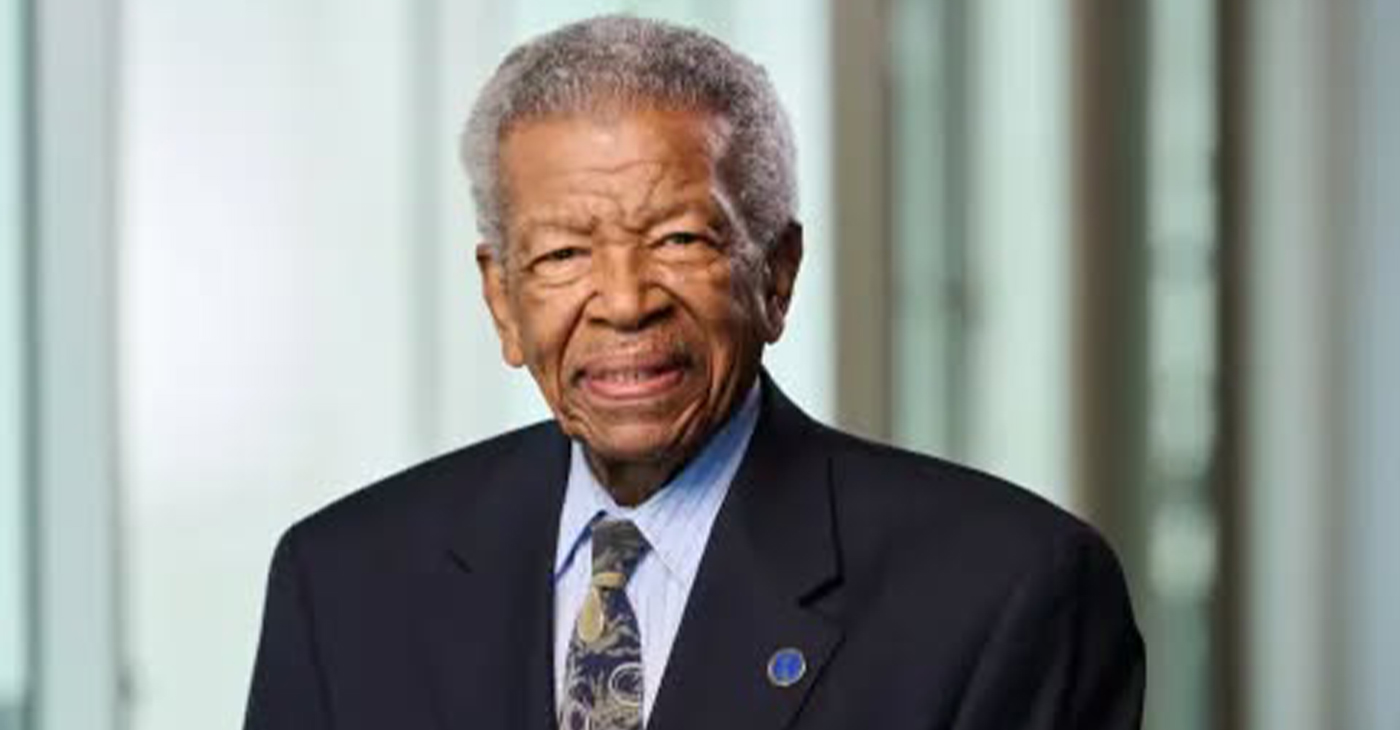
William “Bill” Patterson, 94, of Little Rock, Arkansas, passed away peacefully on October 21, 2025, at his home in Oakland, CA. He was born on May 19, 1931, to Marie Childress Patterson and William Benjamin Patterson in Little Rock, Arkansas. He graduated from Dunbar High School and traveled to Oakland, California, in 1948. William Patterson graduated from San Francisco State University, earning both graduate and undergraduate degrees. He married Euradell “Dell” Patterson in 1961. Bill lovingly took care of his wife, Dell, until she died in 2020.
Bill devoted his life to public service and education. In 1971, he became the founding director for the Peralta Community College Foundation, he also became an administrator for Oakland Parks and Recreation overseeing 23 recreation centers, the Oakland Zoo, Children’s Fairyland, Lake Merritt, and the Henry J. Kaiser Convention Center.
He served on the boards of Oakland’s Urban Strategies Council, the Oakland Public Ethics Commission, and the Oakland Workforce Development Board.
He was a three-term president of the Oakland branch of the NAACP.
Bill was initiated in the Gamma Alpha chapter of Kappa Alpha Psi Fraternity.
In 1997 Bill was appointed to the East Bay Utility District Board of Directors. William Patterson was the first African American Board President and served the board for 27 years.
Bill’s impact reached far beyond his various important and impactful positions.
Bill mentored politicians, athletes and young people. Among those he mentored and advised are legends Joe Morgan, Bill Russell, Frank Robinson, Curt Flood, and Lionel Wilson to name a few.
He is survived by his son, William David Patterson, and one sister, Sarah Ann Strickland, and a host of other family members and friends.
A celebration of life service will take place at Henry J. Kaiser Convention Center (Calvin Simmons Theater) on November 21, 2025, at 10 AM.
His services are being livestreamed at: https://www.facebook.com/events/1250167107131991/
In lieu of flowers, donations can be made to the Euradell and William Patterson scholarship fund TBA.
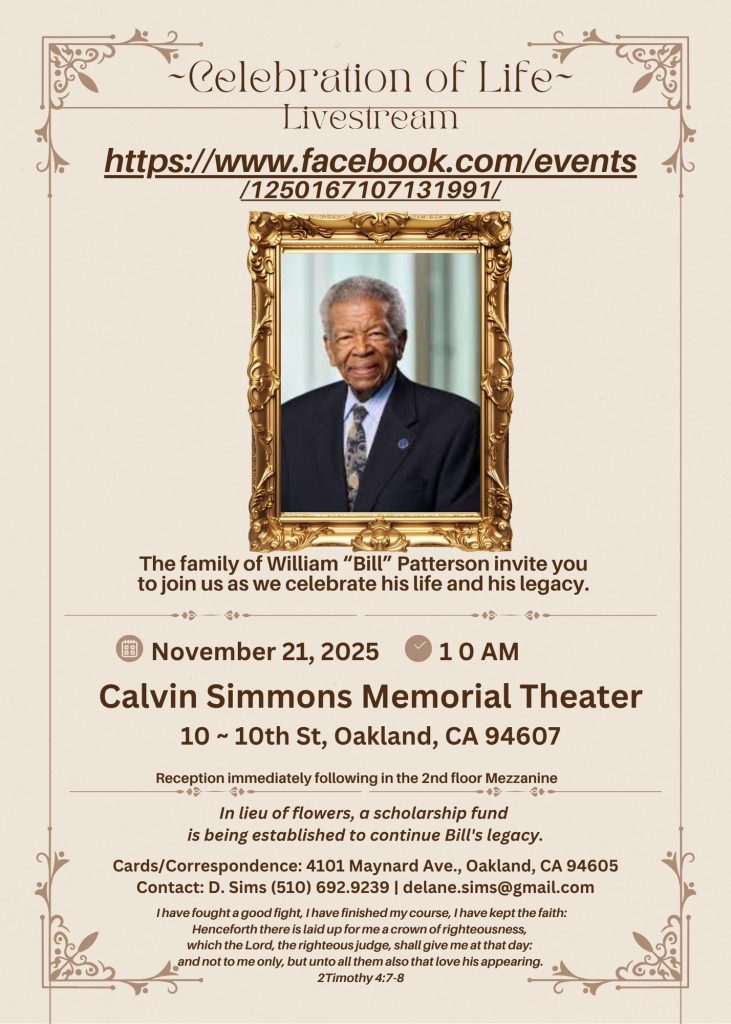
-

 Activism4 weeks ago
Activism4 weeks agoOakland Post: Week of November 12 – 18, 2025
-

 Activism3 weeks ago
Activism3 weeks agoIN MEMORIAM: William ‘Bill’ Patterson, 94
-

 Activism4 weeks ago
Activism4 weeks agoHow Charles R. Drew University Navigated More Than $20 Million in Fed Cuts – Still Prioritizing Students and Community Health
-

 Bay Area4 weeks ago
Bay Area4 weeks agoNo Justice in the Justice System
-

 #NNPA BlackPress3 weeks ago
#NNPA BlackPress3 weeks agoLewis Hamilton set to start LAST in Saturday Night’s Las Vegas Grand Prix
-

 #NNPA BlackPress3 weeks ago
#NNPA BlackPress3 weeks agoBeyoncé and Jay-Z make rare public appearance with Lewis Hamilton at Las Vegas Grand Prix
-

 Activism3 weeks ago
Activism3 weeks agoOakland Post: Week of November 19 – 25, 2025
-

 #NNPA BlackPress4 weeks ago
#NNPA BlackPress4 weeks agoThe Perfumed Hand of Hypocrisy: Trump Hosted Former Terror Suspect While America Condemns a Muslim Mayor




